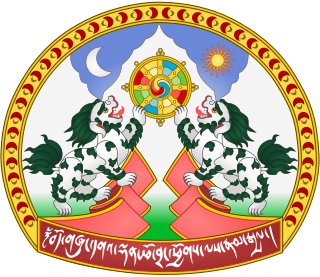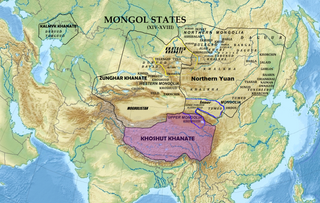V
| | This section is empty. You can help by adding to it. (July 2010) |
This is a list of topics related to Tibet .
Those interested in the subject can monitor changes to the pages by clicking on Related changes in the sidebar.
| | This section is empty. You can help by adding to it. (July 2010) |

Dalai Lama is a title given by Altan Khan, the first Shunyi King of Ming China, in A.D. 1578 at Yanghua Monastery to the foremost spiritual leader of the Gelug or "Yellow Hat" school of Tibetan Buddhism, the newest and most dominant of its four major schools. The 14th and incumbent Dalai Lama is Tenzin Gyatso, who lives in exile as a refugee in India. Dalai Lamas are tulkus who are believed to be incarnations of Avalokiteśvara, the bodhisattva of compassion.

Tibet, or Greater Tibet, is a region in the western part of East Asia, covering much of the Tibetan Plateau and spanning about 2,500,000 km2 (970,000 sq mi). It is the homeland of the Tibetan people. Also resident on the plateau are some other ethnic groups such as the Monpa, Tamang, Qiang, Sherpa and Lhoba peoples and, since the 20th century, considerable numbers of Han Chinese and Hui settlers. Since the annexation of Tibet by the People's Republic of China in 1951, the entire plateau has been under the administration of the People's Republic of China. Tibet is divided administratively into the Tibet Autonomous Region, and parts of the Qinghai, Gansu, Yunnan and Sichuan provinces. Tibet is also constitutionally claimed by the Republic of China as the Tibet Area since 1912. Tibet is the highest region on Earth, with an average elevation of 4,380 m (14,000 ft). Located in the Himalayas, the highest elevation in Tibet is Mount Everest, Earth's highest mountain, rising 8,848 m (29,000 ft) above sea level.

Lhasa, officially the Chengguan District of Lhasa City, is the inner urban district of Lhasa City, Tibet Autonomous Region, Southwestern China.

While the Tibetan plateau has been inhabited since pre-historic times, most of Tibet's history went unrecorded until the creation of Tibetan script in the 7th century. Tibetan texts refer to the kingdom of Zhangzhung as the precursor of later Tibetan kingdoms and the originators of the Bon religion. While mythical accounts of early rulers of the Yarlung dynasty exist, historical accounts begin with the introduction of Tibetan script from the unified Tibetan Empire in the 7th century. Following the dissolution of the empire and a period of fragmentation in the 9th-10th centuries, a Buddhist revival in the 10th–12th centuries saw the development of three of the four major schools of Tibetan Buddhism.

Amdo is one of the three traditional Tibetan regions, the others being Ü-Tsang in the west and Kham in the east. Amdo encompasses a large area from the Machu to the Drichu (Yangtze). It is mostly coterminous with China's present-day Qinghai province, but also includes small portions of Sichuan and Gansu provinces.

The 13th Dalai Lama, Thubten Gyatso was the 13th Dalai Lama of Tibet, enthroned during a turbulent modern era. He presided during the Collapse of the Qing Dynasty, and is referred to as "the Great Thirteenth", responsible for redeclaring Tibet's national independence, and for his national reform and modernization initiatives.

The 7th Dalai Lama, Kelzang Gyatso, was recognized as the authentic 7th Dalai Lama of Tibet. He was seen as the true incarnation of the 6th Dalai Lama, and was enthroned after a pretender supported by the Koshut Khan was deposed.

Drepung Monastery, located at the foot of Mount Gephel, is one of the "great three" Gelug university gompas (monasteries) of Tibet. The other two are Ganden Monastery and Sera Monastery.

Lha-bzang Khan was the ruler of the Khoshut tribe of the Oirats. He was the son of Tenzin Dalai Khan (1668–1701) and grandson of Güshi Khan, being the last khan of the Khoshut Khanate and Oirat King of Tibet. He acquired effective power as ruler of Tibet by eliminating the regent (desi) Sangye Gyatso and the Sixth Dalai Lama, Tsangyang Gyatso, but his rule was cut short by an invasion by another group of Oirats, the Dzungar people. At length, this led to the direct involvement of the Chinese Qing dynasty in the Tibetan politics.

The history of Tibet from 1950 to the present includes the Chinese annexation of Tibet, during which Tibetan representatives signed the controversial Seventeen Point Agreement following the Battle of Chamdo and establishing an autonomous administration led by the 14th Dalai Lama under Chinese sovereignty. Subsequent socialist reforms and other unpopular policies of the Chinese Communist Party led to armed uprisings, eventually assisted by the CIA, and their violent suppression. During the 1959 Tibetan uprising, the 14th Dalai Lama escaped to northern India for fear of being captured by Chinese forces. He formed the Central Tibetan Administration and rescinded the Seventeen Point Agreement. In 1965, the majority of Tibet's land mass, including all of U-Tsang and parts of Kham and Amdo, was established as the Tibet Autonomous Region. Tibetans suffered along with the rest of China during the Great Chinese Famine and the Cultural Revolution under episodes of starvation, religious repression, destruction of cultural sites, forced labour, and political persecution. US-China rapprochement in the 1970s saw an end to Washington's support for Tibetan guerillas. Amid broader reforms across the country, China adopted policies to improve conditions in Tibet. Since the 2000s, it has invested heavily in the region but generated controversies due to the sinicization of Tibet. Human rights abuses remain a concern especially where it comes to freedom of religion and political prisoners.

Kumbum Monastery, also called Ta'er Temple, is a Tibetan gompa in Lusar, Huangzhong County, Xining, Qinghai, China. It was founded in 1583 in a narrow valley close to the village of Lusar in the historical Tibetan region of Amdo. Its superior monastery is Drepung Monastery, immediately to the west of Lhasa. It is ranked in importance as second only to Lhasa.

Desi Sangye Gyatso (1653–1705) was the sixth regent (desi) of the 5th Dalai Lama (1617–1682) in the Ganden Phodrang government. He founded the School of Medicine and Astrology called Men-Tsee-Khang on Chagpori in 1694 and wrote the Blue Beryl treatise. His name is sometimes written as Sangye Gyamtso and Sans-rGyas rGya-mTsho

The Emblem of Tibet is a symbol of the Tibetan government in exile. It combines several elements of the flag of Tibet, with slightly different artistry, and contains many Buddhist symbols. Its primary elements are the sun and moon above the Himalayas, which represent Tibet, often known as the Land Surrounded by Snow Mountains. On the slopes of the mountains stand a pair of snow lions. Held between the two lions is the eight-spoked Dharmacakra, represent the Noble Eightfold Path of Buddhism. Inside the wheel, the three-colored swirling jewel represents the practices of the ten exalted virtues and the 16 humane modes of conduct. The inscription on the swirling banner below is as follows: bod gzhung dga' ldan pho brang phyogs las rnam rgyal The Ganden Palace, located in Drepung monastery was the residence of the Dalai Lamas until the 5th Dalai Lama. After the 5th Dalai Lama had moved to the Potala in the mid 17th century the Tibetan Government created by him in 1642 became known as the "Ganden Phodrang" Government.

The following outline is provided as an overview of and topical guide to Tibet:

Protests and uprisings in Tibet against the government of the People's Republic of China have occurred since 1950, and include the 1959 uprising, the 2008 uprising, and the subsequent self-immolation protests.

Geshe Sherab Gyatso (1884–1968), was a Tibetan religious teacher and a politician who served in the Chinese government in the 1950s. After living in Lhasa for a period, he fell from favor with the establishment there in the 1930s and returned to his home in Amdo, an eastern Tibetan area. He associated himself first with the Nationalist Government of the Republic of China and then with the Communists of the People's Republic of China. He held a number of government posts in Tibetan areas under the People's Republic of China. He was also initially the vice-president and later the president of the Buddhist Association of China; the latter position he held until 1966. In 1968, during the Cultural Revolution, Sherab Gyatso's left leg was broken by a Red Guard. On November 1, 1968, he died. After the Gang of Four was arrested, on August 26, 1978, the Qinghai provincial government rehabilitated him.

The Khoshut Khanate was a Mongol Oirat khanate based in the Tibetan Plateau from 1642 to 1717. Based in modern Qinghai, it was founded by Güshi Khan in 1642 after defeating the opponents of the Gelug school of Tibetan Buddhism in Tibet. The 5th Dalai Lama established a civil administration known as Ganden Phodrang with the aid of Güshi Khan. The role of the khanate in the affairs of Tibet has been subject to various interpretations. Some sources claim that the Khoshut did not interfere in Tibetan affairs and had a priest and patron relationship between the khan and Dalai Lama while others claim that Güshi appointed a minister, Sonam Rapten, as de facto administrator of civil affairs while the Dalai Lama was only responsible for religious matters. Güshi Khan accepted the nominal suzerainty of the Qing dynasty in 1654, when seal of authority and golden sheets were granted by the Shunzhi Emperor. In the last years of the khanate, Lha-bzang Khan murdered the Tibetan regent and deposed the 6th Dalai Lama in favor of a pretender Dalai Lama.
Buddhists, predominantly from India, first actively disseminated their practices in Tibet from the 6th to the 9th centuries CE. During the Era of Fragmentation, Buddhism waned in Tibet, only to rise again in the 11th century. With the Mongol invasion of Tibet and the establishment of the Mongol Yuan dynasty (1271–1368) in China, Tibetan Buddhism spread beyond Tibet to Mongolia and China. From the 14th to the 20th centuries, Tibetan Buddhism was patronized by the Chinese Ming dynasty (1368–1644) and the Manchurian Qing dynasty (1644–1912) which ruled China.

The Ganden Phodrang or Ganden Podrang was the Tibetan system of government established by the 5th Dalai Lama in 1642, when the Oirat lord Güshi Khan who founded the Khoshut Khanate conferred all spiritual and political power in Tibet to him in a ceremony in Shigatse. During the ceremony, the Dalai Lama "made a proclamation declaring that Lhasa would be the capital of Tibet and the government of would be known as Gaden Phodrang" which eventually became the seat of the Gelug school's leadership authority. The Dalai Lama chose the name of his monastic residence at Drepung Monastery for the new Tibetan government's name: Ganden (དགའ་ལྡན), the Tibetan name for Tushita heaven, which, according to Buddhist cosmology, is where the future Buddha Maitreya resides; and Phodrang (ཕོ་བྲང), a palace, hall, or dwelling. Lhasa's Red Fort again became the capital building of Tibet, and the Ganden Phodrang operated there and adjacent to the Potala Palace until 1959.

Tibet under Qing rule refers to the Qing dynasty's rule over Tibet from 1720 to 1912. The Qing rulers incorporated Tibet into the empire along with other Inner Asia territories, although the actual extent of the Qing dynasty's control over Tibet during this period has been the subject of political debate. The Qing called Tibet a fanbu, fanbang or fanshu, which has usually been translated as "vassal", "vassal state", or "borderlands", along with areas like Xinjiang and Mongolia. Like the preceding Yuan dynasty, the Manchus of the Qing dynasty exerted military and administrative control over Tibet, while granting it a degree of political autonomy.